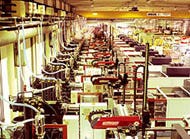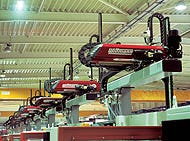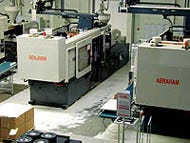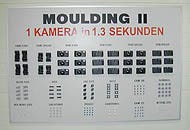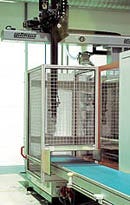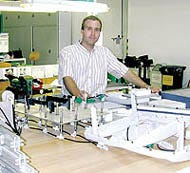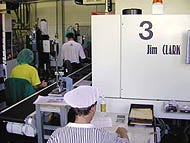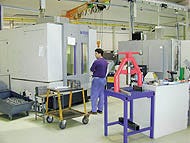Molding is big man on this campus
December 1, 2001
The term "flexibility" is often overused in the molding business, but it is hard to avoid when talking about contract manufacturing. Providing upstream outsourcing flexibility to OEMs by assuming full manufacturing responsibility is at the very heart of why contract manufacturers exist. Flextronics, one of the biggest and best known in the category ($15 billion in 2001 revenue), puts the concept in its name. A visit with management of the Flextronics facility in Sárvár, Hungary clearly shows how the company practices what it preaches and gains many advantages in the process.
|
|
The majority of injection molding machines in Sárvár are less than three years old, and Flextronics has more than 400 active tools at this facility. | Flextronics wants robotics for their speed and consistency, but also requires flexible production systems. Wittmann supplies units that are easily reprogrammable for use with different products, molds, and machines. |
|
|
The machines have names, which are easier to remember than numbers. They include movie stars and Formula One drivers like Fittipaldi and Clark on the high-speed machines. One group of eight has the names of Snow White and the Seven Dwarves—in Hungarian. | There are four other companies in the industrial buildings on the Flextronics campus in Sárvár, Hungary. Though there is room for expansion, the labor supply is a limiting factor. |
A Manufacturing Campus
The Flextronics manufacturing campus model that integrates a variety of suppliers in one location—from molding to assembly to packaging—is fairly well known. Sárvár wasn't started as a campus, but evolved into one quickly. Flextronics owns the land and buildings on this campus, but it is not alone. Other firms include Hirsch, which makes EPS packaging components; Antec, which fabricates sheet metal; and SCA, which produces cardboard packaging. Netherlands-based Versteijnen, a trucking company, is here, and several other shippers use the campus as a staging point.
Given what Flextronics makes, the kind of packaging used, and the need to ship abroad, the affinities of the companies are apparent, but this assembly of specialists is more fortuitous than intentional. When Flextronics opened in Hungary in 1995, Hirsch was already in the area and SCA was looking for a location. The companies talked and the campus began to take shape. It has grown as additional customers were added.
Despite their proximity on the campus, the companies avoid interdependence. They are not tied by contracts, and they each supply other noncampus customers. Flextronics' work is not automatically handed to the other firms and not all of it goes to them. Gernot Weiss, an Austrian who is Flextronics' executive director for Central Eastern Europe, says they all have to be competitive or no one is. That said, the advantages are obvious. Communications of all types are simpler and faster. And deliveries? The lift truck that picks and palletizes does not load a truck; it goes across the parking lot and makes the delivery. It's hard to be more JIT than that.
About 4000 people work on the campus, the majority for Flextronics. This workforce is cross-trained so it can move to different operations. Computer printers are more popular at Christmas. Single-use cameras sell better in vacation months. Weiss says this is a win-win proposition. The company has production flexibility and the employees enjoy greater assurance of constant wages at the same location. An assembler making cameras in the spring can make printers in the fall. The assembly operation generally works two 8-hour shifts per day. A third shift is added for peak periods.
|
The parts produced by Flextronics for single-use cameras are illustrated on this chart. Flextronics produces a complete camera every 1.3 seconds. |
|
|
Developed with Wittmann and Ferromatik, this safety cage design allows the door, safety enclosure, and conveyor to move out of the way together, leaving the clamp area totally open for mold changing or maintenance. The design is being adapted to other machines. | Standing in the mold maintenance area, Balázs Kalmár is pictured with the paint and printing fixtures and robot end-of-arm tooling that the mold shop also builds. |
|
|
This high-speed machine carries the name of a race car driver. For efficiency, Tampo printing operations for this packaging product have been moved to the press. | Flextronics' toolroom was established for maintenance only. Simple tools began to be produced a few years ago, and today the shop is expanding into production of more complicated tools with the addition of equipment like these new high-speed machining centers. |
Molding Flexibility
Gernot Weiss says a key to Flextronics' competitive strength is its top-level assembly know-how for any kind of electronic component or finished product. This expertise helped it win Microsoft's highly-coveted European Xbox game console business. He is talking about mechanical and electromechanical assembly and not the electronics. A Flextronics plant 40 km away, or various outside firms, supplies printed circuit boards. Still, in spite of this assembly expertise, Weiss says the core technology at this facility is injection molding. A walk through the well-organized molding area with Balázs Kalmár, manager of the plastics business unit, shows why.
The first machines IMM saw were a line of 13 new accumulator-equipped Ferromatik systems, each integrated with a Wittmann robot. They were being set up and tested to start production of the Xbox. (Microsoft says it plans to introduce the Xbox in Europe in spring/summer 2002 with about 1.5 million units.) So, we asked, are the molding machines dedicated to the Xbox? Kalmár's answer is yes . . . and no. It expects the Xbox to be a great success, but the concept of a dedicated machine does not square with Flextronics' strategy. When machines are evaluated for this facility, a high value is placed on adaptability. They need to accommodate changes in product mix.
Werner Wittmann, president of the company that bears his name, says flexibility was also at the top of Flextronics' list of requirements for automation on the new machines, and for that matter, for robotics on all of its machines. The systems integrated by Wittmann and Ferromatik are basically standard designs, says Wittmann, with specific programming for the individual products being molded. Machines and robotics are designed for easy reprogramming and will store many product setups to support rapid changes.
Flextronics has 83 injection machines at Sárvár ranging from 25 to 1050 tons. Most are between 150 and 600 tons and 71 are in the main production hall. Others are in an area used to mold thin-wall technical parts. Material blending for these high-speed machines is on the press, while the others are served by a centralized material handling system. Kalmár says press-side blending is used because color for the technical parts is often 2 percent or less of a 40g shot, and it is a critical parameter. One pellet left in a tube could be a major problem. Camera housings, for example, have a specific optical-density requirement to avoid unintentional exposure of the film.
Other machines in the plant come from Engel, and 13 are of the tiebarless variety. Kalmár says this design has dramatically increased flexibility in tool management. Flextronics has a number of molds that are oversized for the amount of clamp force required. The lack of tiebars lets tools run in machines with minimum clamp tonnage.
Molding technologies practiced at Flextronics include multicomponent, gas assist, and the high-speed molding of complex technical parts with walls of less than .3 mm. The molding area operates 24/7/365 in 12-hour shifts. Employees typically work two night shifts, have two days off, and then two day shifts and two days off. Flextronics recycles almost all scrap onsite and is looking to add a system to pelletize scrap. This would ensure more consistent dosing, particularly for the increasing number of molds with 10- to 40g shots.
Beyond Molding
The Flextronics facility at Sávár offers a strategically desirable manufacturing/shipping point near the Austrian border with lower labor costs than its neighbors to the west. However, Weiss says the lower labor cost is only one of the factors behind the company's growth in Hungary, and not the most important. Other considerations include the following: Hungary's political system, stabilized in the early 90s, is a candidate for early entry into the EU; many in the region speak German and the youngsters learn English in school; and perhaps most important is the presence of educated and experienced engineers and technicians. Weiss says many recently won orders, including production of Microsoft's Xbox, are attributable to design and engineering strength with low labor cost in a secondary role.
Customers such as Hewlett-Packard and Epson (computer printers); Grundig, Panasonic, and Nokia (televisions); Sony (audio and video); and Kodak (single-use cameras) will not sacrifice quality for price, says Weiss. Flextronics has adopted a multiplant strategy that allows simple products to migrate to lower-labor-cost areas such as eastern Hungary now, and perhaps further east in the future.
Complex products that require engineering development are likely to stay in locations such as Sávár. The engineering section there includes tool repair and maintenance; fixtures for painting, welding, and EOAT; moldmaking; and a design group with four Unigraphics workstations. Linked CAD and CAM systems provide seamless transfer of design files to CNC machines. The complexity of tools built here has been moving from simple to sophisticated in stages, and molds are also sourced from Flextronics' moldmaking shop in Italy or independent shops in Asia, Italy, and Portugal.
Contact information |
You May Also Like
